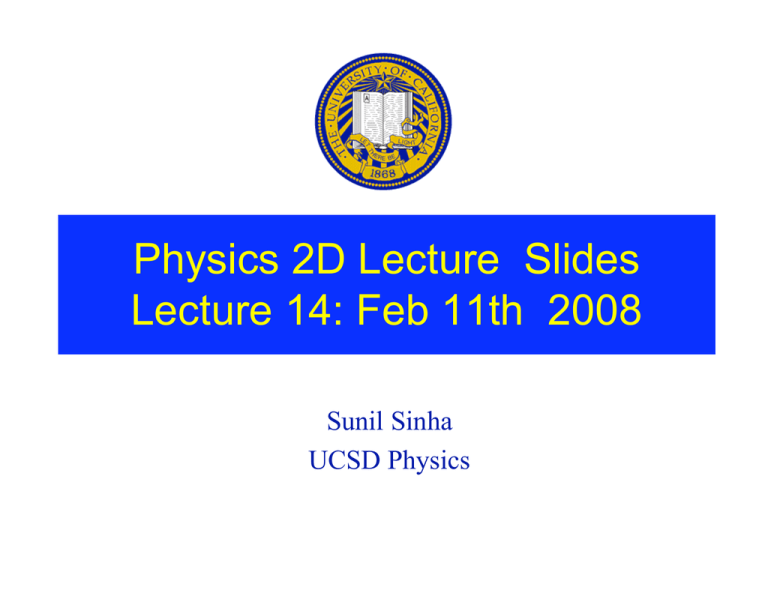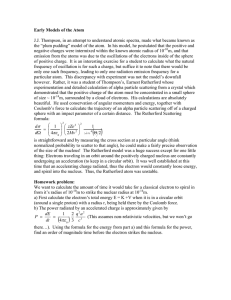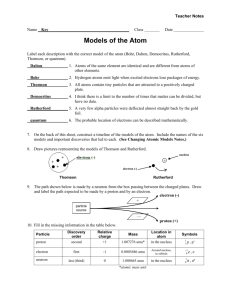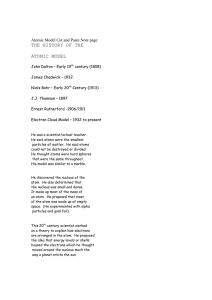Physics 2D Lecture Slides Lecture 14: Feb 11th 2008
advertisement

Physics 2D Lecture Slides Lecture 14: Feb 11th 2008 Sunil Sinha UCSD Physics Thomson’s Determination of e/m of the Electron • In E Field alone, electron lands at D • In B field alone, electron lands at E • When E and B field adjusted to cancel each other’s force electron lands at F e/m = 1.7588 x 1011 C/Kg Millikan’s Measurement of Electron Charge Find charge on oil drop is always in integral multiple of some Q qe = 1.688 x 10-19 Coulombs me = 9.1093 x 10-31 Kg Fundamental properties (finger print) of electron (similarly can measure proton properties etc) Where are the electrons inside the atom? Early Thought: “Plum pudding” model Atom has a homogenous distribution of Positive charge with electrons embedded in them (atom is neutral) Positively charged ematter e + Core e e e- eee + ee- e- e- ee- e eee- e or ? • How to test these hypotheses? Shoot “bullets” at the atom and watch their trajectory. What Kind of bullets ? •Indestructible charged bullets Ionized He++ atom = α++ particles •Q = +2e , Mass Mα=4amu >> me , Vα= 2 x 10 7 m/s (non-relavistic) [charged to probe charge & mass distribution inside atom] Plum Pudding Model of Atom • Non-relativistic mechanics (Vα/c = 0.1) • In Plum-pudding model, α-rays hardly scatter because – Positive charge distributed over size of atom (10-10m) – Mα >> Me (like moving truck hits a bicycle) – predict α-rays will pass thru array of atoms with little scatter (~1o) Need to test this hypothesis Ernest Rutherford Probing Within an Atom with α Particles • • • Most α particles pass thru gold foil with nary a deflection SOME (≅10-4) scatter at LARGE angles Φ Even fewer scatter almost backwards Why “Rutherford Scattering” discovered by his PhD Student (Marsden) Rutherford Discovers Nucleus (Nobel Prize) Force on α-particle due to heavy Nucleus ! particle trajectory is hyperbolic Scattering angle is related to impact par. •Outside radius r =R, F ∝ Q/r2 •Inside radius r < R, F ∝ q/r2 = Qr/R2 •Maximum force at radius r = R # kq! Q $ # "$ Impact Parameter b = % cot & 2 &% 2( ' m! v! ( ' Rutherford Scattering: Prediction and Experimental Result #n = k 2 Z 2 e 4 NnA 2 $1 2 % 4 R & m! v! ' Sin 4 (" / 2) (2 ) 2 •# scattered Vs φ depends on : •n = # of incident alpha particles •N = # of nuclei/area of foil •Ze = Nuclear charge • Kα of incident alpha beam •A= detector area Rutherford Scattering & Size of Nucleus nucleus distance of closest appoach # r size of nucleus 1 Kinetic energy of ! = K! = m! v"2 2 ! particle will penetrate thru a radius r until all its kinetic energy is used up to do work AGAINST the Coulomb potential of the Nucleus: K! = % (Ze )(2e ) 1 m! v"2 = 8MeV = k 2 r 2kZe 2 r= K! For K! =7.7.MeV, Z % nucleus Al = 13 2kZe 2 r= = 4.9 &10$15 m K! Size of Nucleus = 10-15 m Size of Atom = 10-10 m Dimension Matters ! -15 Size of Nucleus = 10 m -10 Size of Atom = 10 m •how are the electrons located inside an atom •How are they held in a stable fashion •necessary condition for us to exist ! •All these discoveries will require new experiments and observations Rutherford Atom & Classical Physics ? Continuous & Discrete spectra of Elements Visible Spectrum of Sun Through a Prism Emission & Absorption Line Spectra of Elements Kirchhoff’ Experiment : “D” Lines in Na D lines darken noticeably when Sodium vapor introduced Between slit and prism Emission & Absorption Line Spectrum of Elements •Emission line appear dark because of photographic exposure Absorption spectrum of Na While light passed thru Na vapor is absorbed at specific λ Spectral Observations : series of lines with a pattern • Empirical observation (by trial & error) • All these series can be summarized in a simple formula # 1 1 1& = R % 2 " 2 ( , ni > n f , ni = 1,2,3,4.. ! $ n f ni ' Fitting to spectral line series data "1 R=1.09737 ) 10 m How does one explain this ? 7 The Rapidly Vanishing Atom: A Classical Disaster ! Not too hard to draw analogy with dynamics under another Central Force Think of the Gravitational Force between two objects and their circular orbits. Perhaps the electron rotates around the Nucleus and is bound by their electrical charge M1M 2 F= G r2 Q1Q2 ! k 2 r Laws of E&M destroy this equivalent picture : Why ? Bohr’s Bold Model of Atom: Semi Quantum/Classical -e 1. Electron in circular orbit me 2. F V +e 3. r around proton with vel=v Only stationary orbits allowed . Electron does not radiate when in these stable (stationary) orbits Orbits quantized: – Mev r = n h/2π (n=1,2,3…) 4. 2 e U (r ) = !k r 1 KE = me v 2 2 5. Radiation emitted when electron “jumps” from a stable orbit of higher energy stable orbit of lower energy Ef-Ei = hf =hc/λ Energy change quantized • f = frequency of radiation Reduced Mass of 2-body system -e General Two body Motion under a central force me F V +e reduces to r me • • Both Nucleus & e- revolve around their common center of mass (CM) Such a system is equivalent to single particle of “reduced mass” µ that revolves around position of Nucleus at a distance of (e- -N) separation – µ= (meM)/(me+M), when M>>m, µ=m (Hydrogen atom) – Νot so when calculating Muon (mµ= 207 me) or equal mass charges rotating around each other (similar to what you saw in gravitation) Allowed Energy Levels & Orbit Radii in Bohr Model 2 1 e E=KE+U = me v 2 ! k 2 r Force Equality for Stable Orbit " Coulomb attraction = CP Force e 2 me v 2 k 2 = r r me v 2 e2 " KE = =k 2 2r e2 Total Energy E = KE+U= - k 2r Radius of Electron Orbit : mvr = n! n! "v= , mr 1 ke 2 2 substitute in KE= me v = 2 2r n2!2 " rn = , n = 1 , 2,....# 2 mke n = 1 " Bohr Radius a0 12 ! 2 !10 a0 = = 0.529 $ 10 m 2 mke In general rn = n 2 a0 ; n = 1 , 2,....# Negative E " Bound system This much energy must be added to the system to break up the bound atom Quantized orbits of rotation Energy Level Diagram and Atomic Transitions " ke 2 En = K + U = 2r since rn = a0 n 2 , n =quantum number " ke 2 13.6 En = = " eV , n = 1, 2, 3..# 2 2 2a0 n n Interstate transition: n i * n f +E = hf = Ei " E f " ke 2 = 2a0 $ 1 1 % && 2 " 2 '' nf ) ( ni $ 1 1 % && 2 " 2 '' ni ) ( nf 1 f ke 2 $ 1 1 = = " & ! c 2hca0 &( n 2f ni2 $ 1 1 % = R& 2 " 2 ' &n ni ') ( f ke 2 f = 2ha0 % '' ) Hydrogen Spectrum: as explained by Bohr ! ke 2 " Z 2 En = # $ % 2 & 2a0 ' n Bohr’s “R” same as the Rydberg Constant R derived empirically from photographs of the spectral series Another Look at the Energy levels ! ke " Z En = # $ % 2 & 2a0 ' n 2 2 Rydberg Constant Bohr’s Atom: Emission & Absorption Spectra photon photon Some Notes About Bohr Like Atoms • Ground state of Hydrogen atom (n=1) E0= -13.6 eV • Method for calculating energy levels etc applies to all Hydrogenlike atoms -1e around +Ze – Examples : He+, Li++ • Energy levels would be different if replace electron with Muons • Bohr’s method can be applied in general to all systems under a central force (e.g. gravitational instead of Coulombic)






